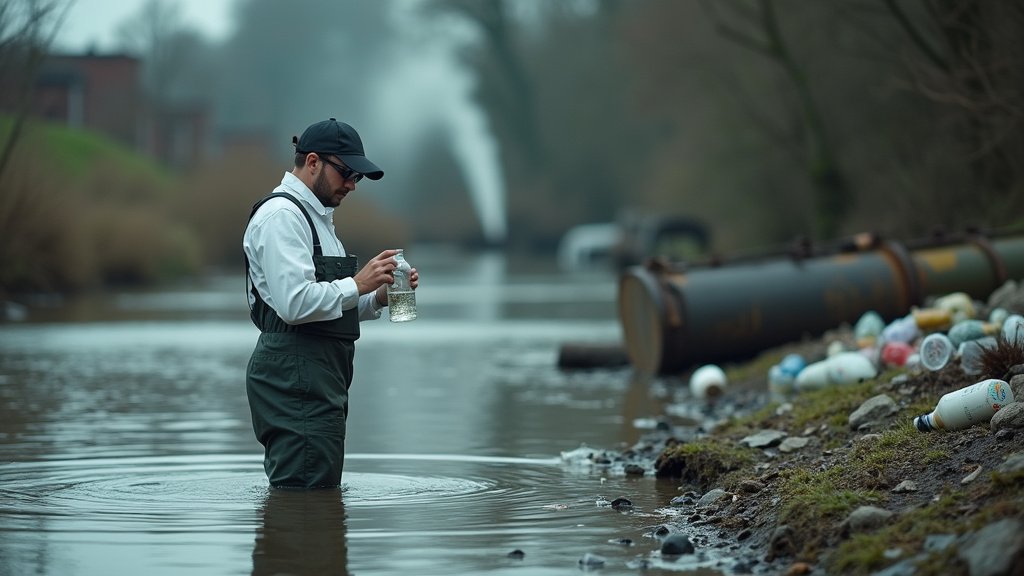Regulators in the United Kingdom face a critical challenge with the pervasive threat of **Chemical Cocktails Waterways**, as revealed by a landmark report from the Royal Society. Existing regulatory frameworks, which typically assess individual chemicals in laboratory settings, are fundamentally inadequate for addressing the complex and cumulative harms posed by these ‘chemical cocktails’ in the nation’s rivers, lakes, and coastal environments. The implications are dire for aquatic ecosystems and potentially for human health, as these **chemical cocktails** can be toxic even when individual components are present at supposedly safe levels, highlighting a significant issue for **Chemical Cocktails Waterways**.
The Hidden Danger of Chemical Cocktails in UK Waterways
The scale of the problem is alarming. Research indicates that **Chemical Cocktails Waterways** are widespread across England’s freshwater systems. Analysis of Environment Agency data has shown that these hazardous combinations, known to harm wildlife, have been found in 81% of river and lake sites and 74% of groundwater sites, contributing to **waterway pollution**. Worryingly, over half of these locations contained three or more of the five harmful chemical cocktails investigated. In some river samples, up to 101 distinct chemicals have been identified, and across all tested catchments in England, nearly 500 different chemicals, some of which are banned, have been detected in various mixtures, demonstrating the pervasive nature of **Chemical Cocktails Waterways**.
These cocktails are not merely additive; their combined effects can be synergistic, meaning the overall toxicity is greater than the sum of their individual parts. Among the most concerning contaminants are persistent ‘forever chemicals’ like PFOS, PFOA, PFBS, and PFHxS, often found alongside pesticides such as 2,4-D and common painkillers like ibuprofen. Emerging contaminants, including pharmaceuticals, micro-pollutants, and residues from personal care products, are also becoming increasingly prevalent in **Chemical Cocktails Waterways**. Furthermore, analyses have detected substances like caffeine, nicotine, antidepressants, antibiotics, and even tyre additives in waterways, primarily stemming from sewage treatment works and road runoff. Legacy pollutants, such as heavy metals and banned pesticides, continue to persist, further complicating the chemical landscape and contributing to **Chemical Cocktails Waterways**.
Regulatory Gaps and Consequences for Chemical Cocktails Waterways
For decades, the United Kingdom’s chemical regulation, including systems like UK REACH, has relied on assessing chemicals one by one, often under controlled laboratory conditions. This approach fails to acknowledge that chemicals in the environment almost always exist as complex mixtures, leading to an underestimation of risks in **Chemical Cocktails Waterways**. Consequently, current monitoring regimes are described as outdated, underfunded, and inadequate, struggling to detect the full spectrum of pollutants and their combined effects. This has led to a situation where, in 2019, not a single river in England met the required chemical status standards, a figure that has only worsened under stricter targets for **Chemical Cocktails Waterways**.
The consequences for **aquatic ecosystems** are severe. Chemical mixtures can impair growth, reproduction, immune function, behaviour, and stress tolerance in fish, invertebrates, and other riverine species, a direct result of **Chemical Cocktails Waterways**. This widespread pollution is a significant driver of **biodiversity loss**, with freshwater species being particularly vulnerable. In UK waters, species like the sturgeon and burbot have vanished, and Atlantic salmon are endangered, partly due to these environmental pressures from **Chemical Cocktails Waterways**. The potential implications for human health, through contact or consumption of contaminated fish, remain largely unknown for many of these complex mixtures present in **Chemical Cocktails Waterways**.
Towards a Precautionary Future for Chemical Cocktails Waterways
In response to these findings, the Royal Society and other environmental groups are calling for a fundamental shift in approach regarding **Chemical Cocktails Waterways**. The report advocates for a pragmatic, yet precautionary principle, emphasizing the need to limit chemical releases into the environment. This includes strengthening regulatory frameworks, such as those overseen by **UK regulators**, to account for **chemical mixtures**, rather than individual substances found in **Chemical Cocktails Waterways**.
Advancements in science and technology offer new avenues for more effective monitoring and regulation of **Chemical Cocktails Waterways**. The report highlights the potential of environmental DNA (eDNA), machine learning, and AI to provide more accurate and cost-effective data on chemical risks. There is also a recognized need to increase training for environmental toxicologists to build the expertise required to tackle this complex issue of **Chemical Cocktails Waterways**. Furthermore, controlling pollution at its source and phasing out the most hazardous chemicals for non-essential uses are crucial steps to mitigate the impact of **Chemical Cocktails Waterways**.
The news has spurred calls for government action, with organizations like The Rivers Trust and Wildlife and Countryside Link demanding robust strategies, increased funding for monitoring programmes, and stronger enforcement from bodies such as the Environment Agency regarding **Chemical Cocktails Waterways**. The aim is to explore and implement innovative solutions that will protect our precious waterways, ensuring they can be enjoyed by future generations while supporting vibrant **aquatic ecosystems** and addressing the pervasive problem of **Chemical Cocktails Waterways**. This evolving situation is a pressing concern, requiring a united effort from government, industry, and the public to safeguard water quality and biodiversity against the threats posed by **Chemical Cocktails Waterways**.





